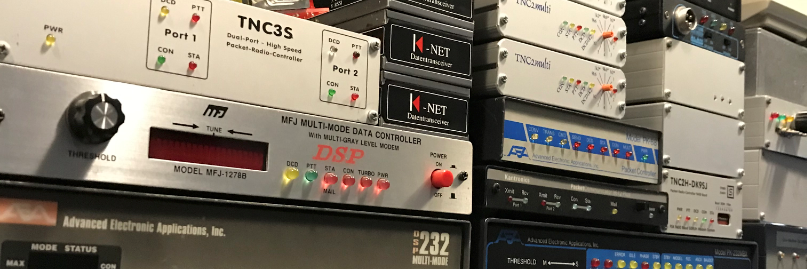
Jean VE2PKT helpt me to get things going. Thank you Jean. I really appreciate it.
I first have to compile a new Jnos version with the NNTP(s) enabled, edit your config.h and define NNTPS.
(#define NNTPS /* Netnews client and server */)
I had problems if I wanted to connect the NNTP server. Jnos crached right away. After a distro update of my linux version from “Stretch” to “Buster” all went fine.
Autoexec.nos
# NNTP server/client start nntp nntp profile fullname "Niels PD9Q" nntp profile host jnos.packet-radio.nl nntp profile organ "Amateur Radio" nntp profile reply pd9q@jnos.packet-radio.nl nntp profile user pd9q # nntp access off nntp firstpoll 5 nntp ihave 0 nntp lzw on nntp quiet 2
Fist create newsgroups on the Jnos prompt
jnos> jnos> nntp create ng.bpq y jnos>
nntp create <news.group.name> [y|n]
Updates the /spool/news/active file, which must have an entry for each news group you wish to receive. Choose y to permit posting to this group, or n to deny posting. y is assumed if nothing is specified. The /spool/news/pointer file is also updated with the path to the directory which will contain the articles. Articles will be stored as separate files, named by an integer corresponding to their arrival order.
The NNTPS software includes a mail-to-news feature, such that email with a To: address that begins with “!” is passed to the NNTPS module. The remainder of the To: address is interpreted as a newsgroup name, with the name truncated at the first occurrence of one of “%@.,/”, and with “!” translated to “.” and “+” to “,”. An alias is usually used to provide this special name. For example, to route all NLD bulletins to both the NLD area, and the NG.NLD newsgroup, use the alias:
/jnos/alias #News groups nld nld !ng!nld My alias file looks like this nld nld !ng!nld bpq bpq !ng!bpq 7plus 7plus !ng!7plus ww ww !ng!ww eu eu !ng!eu aprs aprs !ng!aprs local local !ng!local prop prop !ng!prop
The NNTPS software includes a news-to-mail feature, such that news articles can be emailed to local or remote destinations after they are processed by nntp. This would allow, for example, emailing to a public area, so that BBS users too could read news articles. JNOS must be compiled with NNTPS and NEWS_TO_MAIL #define’d and a file /spool/news/gateway must exist to define the mapping from a newsgroup to an SMTP To: address. Each non-comment line in the gateway file must begin with a newsgroup name (starnames OK), followed by spaces or tabs, followed by the email To: address.
/jnos/spool/news/gateway ng.nld aprs@nld ng.nld prop@nld ng.nld all@nld ng.nld 7plus@nld ng.7plus all@7plus ng.ww all@ww ng.eu all@eu ng.local all@local ng.bpq all@bpq
Expire time of bulletins or newsgroup messages.
/jnos/spool/expire.dat # bulletins received from AX25 network # nld 90 bpq 60 7plus 30 eu 30 check 45 ww 30 prop # # NNTP !ng.nld 90 !ng.bpq 60 !ng.7plus 30 !ng.check 30 !ng.eu 30 !ng.prop 30 !ng.ww 30
I’m using Thunderbird to read and post messages as bulletin and newsgroup mail.
mail.log
Fri Feb 21 20:22:46 2020 queue job 2333 To: !ng!local From: pd9q@jnos.packet-radio.nl Fri Feb 21 20:22:46 2020 queue job 2333 To: local From: pd9q@jnos.packet-radio.nl Fri Feb 21 20:26:50 2020 deliver Msg-Id: 2335@jnos.packet-radio.nl To: local From: pd9q@jnos.packet-radio.nl Subject: Test ng.local
Received: by jnos.packet-radio.nl with NNTP
id AA2332 ; Fri, 21 Feb 2020 20:22:46 CET
Newsgroups: ng.local
From: Niels PD9Q <pd9q@jnos.packet-radio.nl
Subject: Test ng.local
Message-ID: <2331@jnos.packet-radio.nl>
Date: Fri, 21 Feb 2020 20:22:41 +0100
Errors-To: sysop
To: all@local
Test the ng.local newsgroup.
Newsgroups: ng.local X-Mozilla-News-Host: news://192.168.1.101:119 From: Niels PD9Q <pd9q@jnos.packet-radio.nl> Path: jnos.packet-radio.nl!not-for-mail Subject: Test ng.local Message-ID: <2331@jnos.packet-radio.nl> Date: Fri, 21 Feb 2020 20:22:41 +0100 User-Agent: Thunderbird/60.9.1 MIME-Version: 1.0 Content-Type: text/plain; charset=utf-8; format=flowed Content-Language: nl Content-Transfer-Encoding: 7bit Lines: 1 Test the ng.local newsgroup.
Path: jnos.packet-radio.nl!NNTP_GATE@jnos.packet-radio.nl!jnos From: pd9q@jnos.packet-radio.nl Newsgroups: ng.local Subject: Test all@local Message-ID: <c00aaec4-9b7f-b803-b9cd-adc1941ba8b9@jnos.packet-radio.nl> Sender: NNTP@jnos.packet-radio.nl Comments: Article created from mail X-Mozilla-News-Host: news://192.168.1.101:119 To: all@local Date: Fri, 21 Feb 2020 20:53:28 +0100 User-Agent: Thunderbird/60.9.1 MIME-Version: 1.0 Content-Type: text/plain; charset=utf-8; format=flowed Content-Language: nl Content-Transfer-Encoding: 7bit Test all@local bulletin 73 Niels
That’s look pretty cool, isn’t it?




